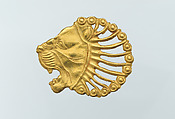Applique in the shape of a lion's head
Not on view
This gold applique is in the form of a lion’s head, facing to the left with its mouth open in a roar. The eye is shown in profile with the lid outlined. Its snout is indicated by a series of raised horizontal lines between the nose and the mouth and above the nose, and two forked whiskers are shown on the cheek. The mouth has two canine teeth, one in the upper jaw and one in the lower, both with a vertical groove. The lion’s tongue is visible behind the lower tooth, and the lips are rendered with two thick lines around the edge of the mouth. The face is separated from the mane by a thick, raised line. Above the line is a pointed ear with two vertical grooves. The openwork mane consists of eleven thick lines radiating from the back of the lion’s head, interspersed with raised dots. The back side of the applique has five rings for attaching it to fabric.
This applique was made by hammering a single sheet of gold and cutting out the open parts of the mane. It would have been attached originally to clothing, along with many other similar appliques. Some of the reliefs from Persepolis depicting the Persian king show decorations on his robe that are probably meant to represent appliques like this. Lions, representing strength and raw power, were a popular feature of Achaemenid art, especially royal iconography. Indeed, very similar renderings of lions’ heads appear on glazed bricks excavated at the Persian capital city of Susa.
Due to rights restrictions, this image cannot be enlarged, viewed at full screen, or downloaded.

